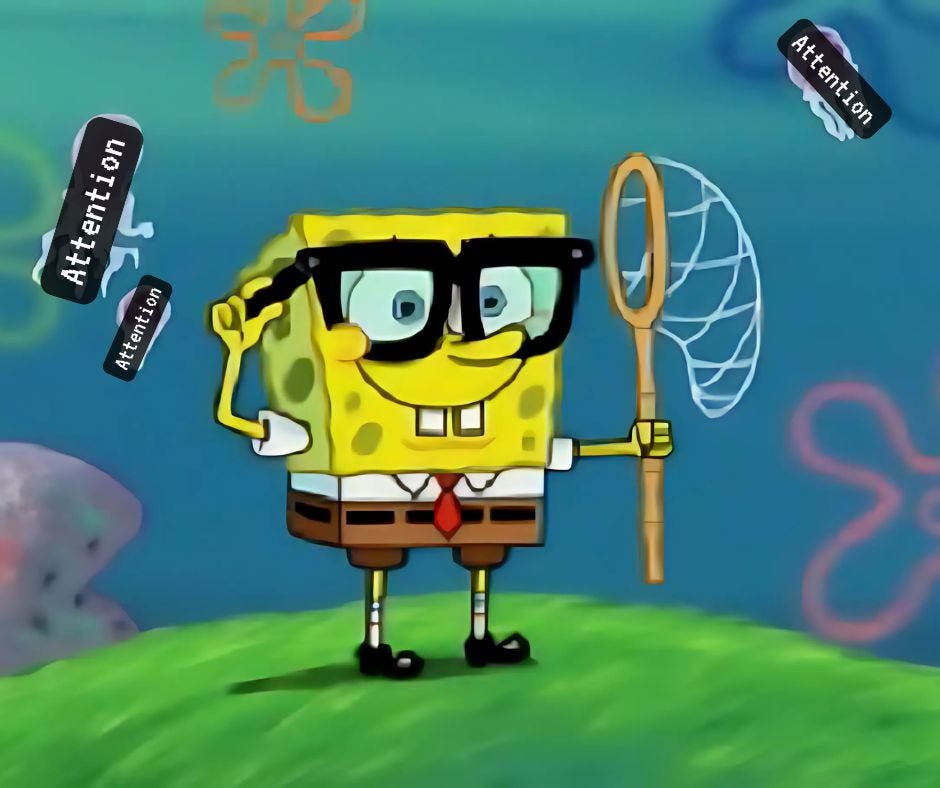The Common-Sense Guide to Catching Attention
and get more people to care about your product, value or brand.
There is a hidden war: with players of all sizes— everyday people, corporate behemoths, A-list celebrities, scrappy influencers, and ambitious one-person businesses puffing themselves up like blowfish.
Interestingly, this war isn't new. But the battleground has changed. The internet has turned us all into brands, each chasing the same elusive prize—
Attention.
And here’s your first bitter pill: No one cares…
And no matter how special your brand feels to you, it is just another voice in the void. Fighting to convince people that your not-so-unique combination of services, products, vision and values deserves their attention—and, hopefully, their money.
Unfortunately, even disruptive trailblazers, those who are first-to-market— eventually find this truth.
No one cares
So, What Now?
Conventional marketing wisdom will tell you this:
Do market research.
Find your target market or niche.
Create a customer persona.
Speak to them in their language.
Shove your product in their face.
Sure, that works—for steady growth, if you’ve got time to wait decades for cultural relevance.
But then a second truth will sneakily hit you with a baseball bat —
You aren’t Apple…
you don’t have their billions or Coca-Cola’s nostalgia. In the battle for attention, You’re David - weak, poor, and ill-equipped. So forget fighting like Goliath on a level playing field.
Get scrappy.
How to Hunt for Attention
To capture attention, you need to do the opposite of conventional marketing wisdom. You need to go viral.
Viral in this case, isn’t about raking hundreds of millions of views (congrats if you manage to do so). Instead, it is about creating content that resonates with a more loosely defined audience i.e. the larger community that houses your niche.
It is finding interesting ways to comment on hot-button topics this loosely defined audience cares about, and then slowly take them down a funnel of more niche concerns as you work towards building community.
However, you can’t build a community if you can’t catch any attention. Here are three techniques to hunt for attention:
Hunt Like a Cat
Cats are cute. Cats play pianos. Cats go viral because they embody fun and positivity. As a cat, you design your brand to infect your audience with good vibes. Simplify hard topics, break down barriers, and make people feel good about themselves.
Create over-the-top copy and advertising. Go out of your way to make your audience smile.
Like Duolingo, pairing humour with learning. Their iconic green owl embodies playful persistence, and a hint of madness, sending users notifications that feel more like inside jokes than marketing.
This doesn’t end with brand campaigns, you can incorporate this into your product design. Brands like Lofree, IKEA or Miniso, build their product design language with cute, cosy or nostalgic vibes.
Cat brands thrive on charm, wholesomeness, their ability to create delight, and a sprinkle of madness.
The Snake
Snakes on the other hand are provocateurs. They stir emotions—shock, rebellion, outrage—and create fiercely loyal fans in the process. Snake brands thrive on controversy, subverting culture to ignite conversations.
Think of Nike and its Colin Kaepernick ad, which polarized audiences but cemented loyalty among its core base. Or the Thailand Health Promotion Board smoking Kid campaign.
Snake brands challenge norms and make people feel something— the more uncomfortable, the better.
The Chimera?
In truth, you don't have to purely be either, your brand could take elements from both depending on the situation - knowing when to charm and when to strike.
Once You’ve Got Their Attention
Getting attention is just the start. The real challenge is keeping it. Once you’ve pulled your audience in, where do you want them to go? How will you get them there?
Grabbing attention is at the very top of the customer journey. Every brand marketer knows that at the top, you’re casting a wide net, pulling in anyone who’ll stop scrolling for half a second to give you a look.
To be impactful, you need to go deeper, each step getting narrower, sharper, and more niche. You’re gradually filtering out the lukewarm and casual observers, leaving behind a core group of people who don’t just notice your brand—they get it.
However, you may not get here because you:
Cast a small net.
Are afraid to stand out.
Attention is Art
Like art, brands, services, products—anything created for an audience other than yourself—cannot afford to be neutral. Whether through design or messaging, they must evoke strong feelings: love or hate. In the words of Seth Godin, they must be remarkable.
Anything less means your brand is blending into the background noise, still searching for its voice.
This is one positive to Jaguar’s most recent rebrand. It sparked provocation and conversation. It is engaging people who haven’t thought about them for decades, casting a wide net to capture new audiences, especially as they try to reach a new type of customer.
This level of reaction wouldn’t have been possible had Jaguar chosen a safer, more traditional route.
Will their bet work? We’ll have to wait and see. But it is undeniable that they have taken a stab at culture, and its impact was felt.
The lesson here is clear: to infect culture, create art. Make people feel something. Whether you charm them like a Cat or provoke them like a Snake, the goal is the same
—leave a fun impression or cause a scene.
Because if people can look at your brand and shrug, then you’ve still got work to do.



